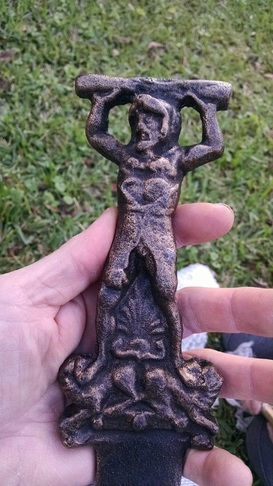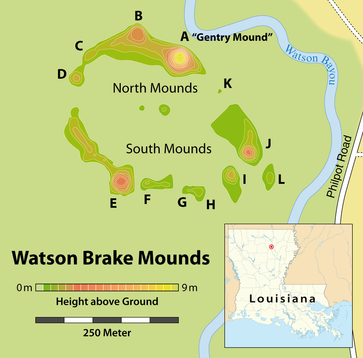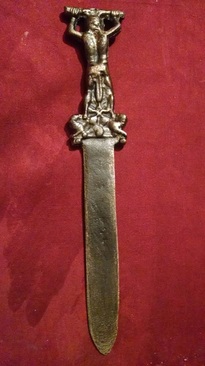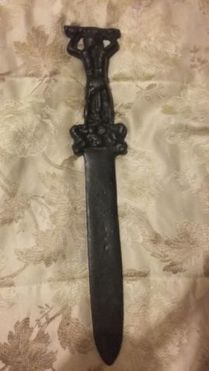| This is funny. In my never-ending quest to get to the bottom of Swordgate, I stumbled across this classified ad on the website Kijiji. Someone in Winnipeg has taken it upon him or herself to attempt to sell a Design Toscano sword for about twice what they sell for on Amazon.com with the following pitch: "A replica blade of a sword that was found in an old shipwrecked roman ship in Canada B.C which would have been the first people to discover Canada before Christopher Columbus but did not report it or make it back. Made of a heavy iron all way through and not sharp at all." The ad (titled "Old Ceremonial or Marine Roman Sword") is dated December 20, two days after the internet discovered that the cast iron "Gladiator's Sword of Pompeii" sold by Design Toscano was identical in design (but not materials) to the Nova Scotia sword touted by J. Hutton Pulitzer as a "100 percent confirmed" Roman artifact. Since I now own a Design Toscano sword, I can tell you that the sword shown in the ad is just that. It may have been painted black, but all the divots on the blades match and it's pretty obviously the same thing. Maybe Pulitzer could autograph these things and include them with his yet-to-be released book "Commodus's Secret." It looks like he's starting a new industry. Normally I would try to format the post so that there isn't all this white space at the bottom, but it's been a long holiday break and I'm just going to live with it. |
|
3 Comments
Thanks to the several of you who have contributed thus far to my Woo War One campaign, we are taking our woo fighting to the next level. Your dollars are already hard at work: I spent $27.90 on one of the Design Toscano iron replica swords from Amazon. Its arrival yesterday caused great excitement among my children. I had to explain to them that this was for science, and they would have to wait until I was done sciencing before they could use it to save the universe.  The handle of the Design Toscano reproduction sword. The handle of the Design Toscano reproduction sword. If you've been following along, you know that my hypothesis is that the Design Toscano swords currently being reproduced are copies of a 19th century curio/souvenir sword rather than an ancient Roman original. J. Hutton Pulitzer and his ilk have asserted over and over again that the Nova Scotia sword, which they claim is a "100 percent confirmed" Roman artifact, matches an authenticated Roman sword housed in an Italian museum. As far as I know, however, they have provided no evidence (no image, no catalog record, no reference, nothing) that the Roman sword that they claim exists actually does exist. At this point I am extremely skeptical. If there is such a sword, where is it? As always, I'm happy to change my thinking in the face of evidence. But I don't trust assertions from Pulitzer or the Ancient Artifact Preservation Society any farther than I can throw them. As the ones making the claim, the burden of proof is on them: I can no more prove that such a sword doesn't exist as I can prove there is not a teapot orbiting the sun. I purchased a Design Toscano sword because I think it may offer some data to help me evaluate my hypothesis about the two "generations" of swords. Copies cannot have details that are not present in the original. Just looking casually at the Design Toscano sword, it obviously lacks much of the fine detail that is visible in at least one of the brass/bronze swords (the California sword). That could possibly be explained by the fact that the Design Toscano sword is of rather crude manufacture (it is billed as a "rough iron foundry casting," after all): perhaps it is just a poor copy of a very fine original artifact. I think it's more likely, however, that the Design Toscano swords were copied from a worn example of a brass/bronze sword from the 1800s rather than a replica of an actual artifact from Pompeii. The Hercules figure on the Design Toscano sword appears to be about the same size as those of the brass/bronze swords. I've made arrangements to borrow the California sword (hopefully it will shipped to me in the coming week) so I'll be able to make a direct comparison. My plan is to use a 3D scanner to create three-dimensional models of the figures that I can then compare directly. Then I'll be able to tell, hopefully, if the differences in detail between the two swords can be attributed to material being lost (as in details being rubbed off) and/or material being added (as one expect from a crude cast of a detailed artifact). The 3D scan data may reveal other interesting things as well. I'll make those data available as I generate them. I also hope to do my own XRF analysis of the California sword to determine the composition of the metal. I'm pretty sure the facilities for doing such an analysis exist at USC, so I'm hoping it will just be a matter of figuring out who I need to talk to get it done (there may be direct costs involved, which is another thing I'll be using the Woo War One money for). I've only just begun looking, but it seems that there are plenty of data available on composition of Roman era copper-alloy artifacts as well as brass of more recent manufacture. This will all be fun, and I'll keep you updated as I make headway and get results. Finally, for the record, the Design Toscano sword has thus far exhibited no magical properties. I'll let you know if the California sword points to "true north" when it gets here. Or increases my armor class or hit points. Or helps me save a princess. In Swordgate, anything is possible. If you haven't read Jason Colavito's recent posts about America's Stonehenge (aka Mystery Hill), you should. Here is the first one. Here is the second one. I visited the America's Stonehenge website after reading Colavito's posts, and noticed the claim that " . . . America's Stonehenge is most likely the oldest man-made construction in the United States (over 4000 years old)." The claim of "oldest construction" is a bold one. It's also wrong. I sent the following email to Mark Eddy, the America's Stonehenge publicist, this morning:  Plan map of the 5500-year-old Watson Brake mound complex. Plan map of the 5500-year-old Watson Brake mound complex. "Dear Mr. Eddy, I read with interest your exchange with Jason Colavito about what you claimed were “inaccuracies and omissions” in his review of an episode of America Unearthed that referenced America’s Stonehenge. After looking at your website, I wanted to point out that the claim that America’s Stonehenge is “most likely the oldest man-made construction in the United States” is incorrect. That statement, featured prominently on your website, is not even close to being true. Even if we accept that the stone constructions are “over 4000 years old” (a claim of which I am extremely skeptical), an age of around 2000 BC would not make these structures the oldest in the United States. Careful archaeological work has demonstrated that Archaic peoples were building earthworks in the Southeast at least as early as 3500 BC. I refer you to information about the Watson Brake mound complex in Louisiana, perhaps the best-documented case of Middle Archaic mound-building in the United States [image source]. Arguments have been made that other artificial mound constructions in the Southeast may pre-date Watson Brake by a thousand years. Either way, it’s clear that people were building large scale structures in the United States well before 2000 BC. If we include above-ground structures such as houses, there are many documented examples of “man-made construction” that pre-date the 5500-year-old monumental earthen constructions of the Southeast. Remains of wooden post structures dating to the Paleoindian through Middle Archaic periods (about 11,500-3,800 BC) have been documented in Illinois, Georgia, Wisconsin, Maine, Virginia, and Mississippi. I refer you to my online database of prehistoric houses for information about those. Finally, I would like to mention the recent, widely-publicized claims for the existence of 9,000-year-old stone hunting structures beneath the waters of Lake Huron. If the dating and the interpretation are correct, those constructions pre-date 2000 BC by five millennia. Even in the best case scenario, the constructions at America’s Stonehenge are nowhere near the “oldest man-made construction in the United States.” I hope that you will consider the direct evidence of numerous artificial structures in the United States that pre-date 2000 BC and take steps to correct the statements that appear on your main page as well as your Facebook page. Respectfully, Andy White" We all want to present accurate information, right? I hope so. I'll keep you posted.
|
All views expressed in my blog posts are my own. The views of those that comment are their own. That's how it works.
I reserve the right to take down comments that I deem to be defamatory or harassing. Andy White
Email me: andy.white.zpm@gmail.com Sick of the woo? Want to help keep honest and open dialogue about pseudo-archaeology on the internet? Please consider contributing to Woo War Two.
Follow updates on posts related to giants on the Modern Mythology of Giants page on Facebook.
Archives
January 2024
Categories
All
|




 RSS Feed
RSS Feed
